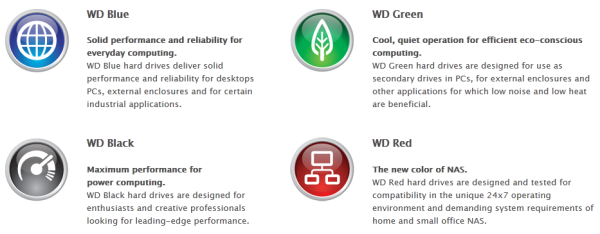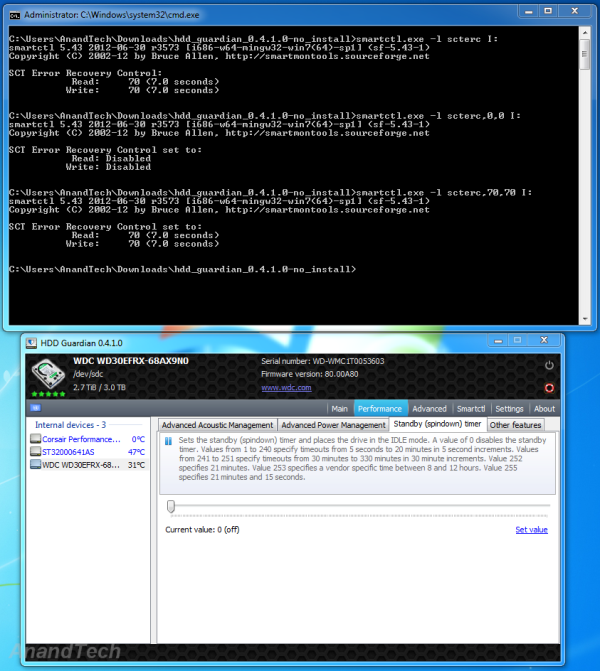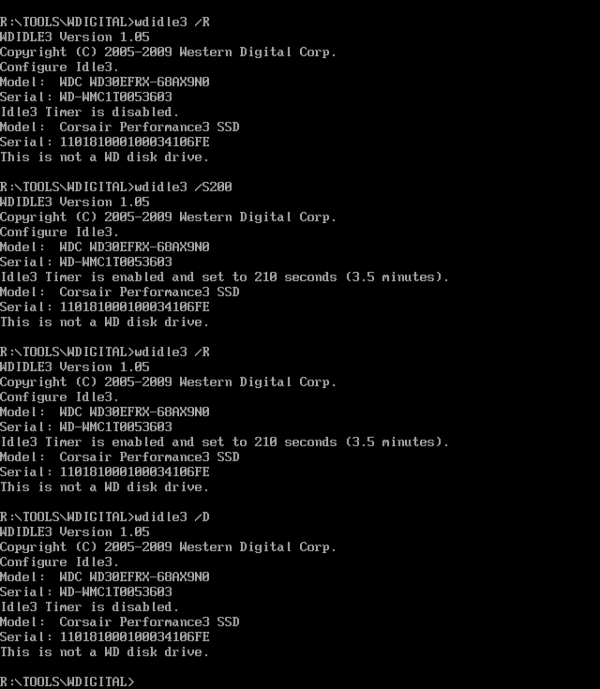Western Digital Red Review: Are NAS-optimized HDDs Worth the Premium?
by Ganesh T S on August 17, 2012 4:20 PM EST- Posted in
- Storage
- NAS
- Western Digital
WD Red Lineup: Differentiating Features
Western Digital has well-defined product categories for each market segment. The WD Black series caters to those requiring a lot of performance without power concerns. The Green series serves the opposite end of the spectrum, where performance is not that much of an issue (secondary drives for PCs / external enclosures), but heat and power could do with some reduction. The Blue series served the middle tier (everyday computing with optimal performance) and the notebook market. However, none of these models are recommended by WD for 24x7 operation (which happens to be an essential requirement for almost all NAS systems). Till now, none of the HDD vendors have anything specific for SMB / SOHO NAS systems. WD aims to capture this segment of the market with the WD Red lineup.
High end enterprise configurations are served by drives rated for stressful conditions (such as Seagate's Constellation and Cheetah lineups, WD's own RE4 and Hitachi's Ultrastar series). These drives commanded a huge price premium that even tempted some IT staff to fill their RAID arrays with consumer hard drives. Unfortunately, most of these temptations have resulted in bad results (particularly if the consumer hard drives have not been properly 'configured' prior to usage). What are the aspects which differentiate these enterprise drives from consumer versions?
SMART Command Transport Error Recovery Control: This feature allows the OS to set a soft time limit for completion of reads and writes. Seagate calls this ERC (Error Recovery Control). Samsung / Hitachi drives term this CCTL (Command Completion Time Limit), while Western Digital gives it the TLER (Time Limited Error Recovery) moniker. In a typical desktop drive, this could be a large number. In case of a bad sector or some other similar issue, the hard disk might keep retrying the access or try to remap the bad sector right away. The OS would remain waiting for the hard disk to deliver its delayed response. In a NAS environment, this delay could prove fatal, with the drive either being dropped or the NAS going into rebuild mode. So, it is essential that the SCT ERC number be set to a duration shorter than what the NAS OS would wait for before declaring the drive dead. Enterprise drives usually allow configuration of this value and set it by default to a low one (because the RAID controller can get hold of or recover the data from the other drives in the NAS).
Vibration Tolerance: NAS systems usually place a large number of drives close together. If vibrations aren't mitigated, it could result in decreased lifespan of the drives. Enterprise drives usually have increased vibration tolerance and also have in-built mechanisms to dampen themselves.
Higher MTBF and Longer Warranties: HDD vendors provide higher Mean Time Between Failures (MTBF) ratings for their enterprise drives and also walk the talk by usually providing longer warranties compared to the desktop drives.
If you are interested in further coverage of these aspects, this page serves as a good starting point. Some studies have shown that there is not much difference between desktop and enterprise hard drives with respect to real-life MTBFs. StorageMojo, in particular, has a number of posts stressing this viewpoint. Assuming that the end user has the data backed up, it is undeniable that the longer warranty period (in which RMA can be processed) is definitely an advantage. It is also likely that if the HDD vendor has enough faith to increase the warranty period, at least some improvements (particularly in the vibration tolerance mechanism) have been done compared to the consumer desktop versions.
Coming back to the WD Red, readers must be wondering how many of the above aspects can be brought to the consumers by WD without eating into their profit margins from the RE4 sales. We first start off with a overview of some of the aspects of the NASware firmware
Intelligent Error Recovery Control: This NASware feature corresponds to the TLER configuration. The value for the soft time limit can be set through smartctl, if the manufacturer allows it. We tried this out on the WD Red drive connected directly to our testbed.
We find that, by default, the soft limit is set to 7s. This means that all the NAS units certified to be compatible with the WD Red drives wait for more than 7s for a transaction to complete before dropping drives or starting a rebuild. The important aspect is that this value is configurable, and can even be completely disabled, as shown in the screenshot above.
Power Management Features: Some hard drives adopt aggressive head parking and disk spindown to save on power. For example, the WD Green drives were guilty of parking the head after just 8 seconds of inactivity. This increases the load cycle count unnecessarily (drives are usually rated for 300K cycles). Disk spindown (or standby) timer is an orthogonal parameter which actually stops the motor and puts the drive in IDLE mode. As the screenshot above shows, the standby timer is off by default, but this value can be altered through HDD Guardian or any other similar software. The head parking parameter is usually accessible through the Advanced Power Management (APM) feature of the hard drive. Unfortunately, HDD Guardian and other HDD tools indicated that there was no APM support in the WD Red. Eventually, we had to resort to running WD's own WDIDLE3 tool in the DOS mode. It turns out that the head parking interval is only accessible through a proprietary command and WD doesn't expose it to external tools.
As the screenshot above shows, head parking is completely disabled by default. It is also possible to set the head parking time limit, and it is sticky through power cycles. For NAS applications, it is better to leave it in the default state of head parking being disabled.
How does the WD Red achieve power optimization? The secret lies in IntelliPower. The WD Red drives spin at 5400 rpm as per the analysis done by the folks at SPCR. It is the combination of these features which allow the WD Reds to balance performance and also reduce power.
3D Active Balance : Vibration Reduction: WD claims that it is the first-to-market with 3D mechanical balancing technology for vibration reduction. This has obvious benefits in terms of decreasing noise and avoiding performance reduction. However, comparative measurements of this feature with the competition is outside the scope of this review.
Some of the other features of the WD Red drives include support for the ATA Streaming Command Set in the firmware. This allows optimal drive buffer management so as to ensure smooth streaming of AV data (particularly when the NAS is acting as a DLNA server). This obviously requires support in the NAS firmware also. In addition, we also have support for the SMART Command Set (SCT). We saw this earlier in this section when using smartctl to get / set the TLER parameters. Note that the SCT doesn't allow altering of the APM parameters for spindown / head parking, as they belong to the non-SMART device settings.













87 Comments
View All Comments
Sivar - Friday, August 17, 2012 - link
"Pretty horrible article, charts are unreadable."I find them easy to read, but if you are having trouble you can click on each to scale it up in size. Ganesh even saved them as PNG, and kept the colors simple (as is best to do with PNG/GIF), so the fine sizes are very small and the charts look as intended (no JPEG artifacts).
"Actual writing is difficult to read, please be more concise."
I found the writing to be of generally high quality. Perhaps you should offer some examples of overly verbose writing. I'm not claiming there aren't any examples, just that providing some will help make your criticisms more constructive. :)
"Oh and crap like "IT departments have been tempted to use consumer drives". Absolute bullshit. If the author has done this he should be fired from his job."
No, it is not.
Your experience may be limited to well-funded, large IT organizations. I have worked in both poorly funded (school / non-profit, etc.) and "by the book" well-funded companies, like the one I am in now.
I have personally used non-enterprise drives in 24/7 RAID arrays. I researched them first, of course. Some even support, or supported, TLER through special utilities. My own home server has eight Samsung F4s that have worked perfectly for almost 3 years (not that a single data point is very useful).
When you have a smaller budget than list of requirements, you make due, and document the reasons for the decisions made. It's part of real-world IT -- not everyone can afford a NetApp storage rack!
Wwhat - Friday, August 17, 2012 - link
To be fair, if you compare the scaled and full sizes of the pictures and see how they don't employ the full available width (compared to the text) when scaled it does seem a bit poorly done, it would have been better to make the pictures slightly wider and slightly less tall and then have them unscaled I think, you'd have simplified things and have them sharp and clear and still not use more bandwidth or require more speed from the reader's internet.yyrkoon - Friday, August 17, 2012 - link
Well Sivar, it is not even that simple. Which you probably know better than I.Department heads for I.T. usually get a budget for different projects. As well as different criteria for every project. So if you need blazing fast access for a very large database for mission critical information. Then of course you're only going to use the best enterprise classed hardware, perhaps in a RAID10 configuration. But redundancy does not nor ever should stop here. There may be several single drive / array redundant copies after that. With probably tape backup as well. With at least one offsite copy to top it off.
Technically though. This drive is not dissimilar to the Consumer classed enterprise version that Seagate has been selling for years. So should be a cut above the rest. With better firmware, hardware, and Q&A testing ( hopefully ). So in effect. An entry level to enterprise drive. But whatever.
cashkennedy - Friday, August 17, 2012 - link
Yes Phynaz's comments about the article are pretty dumb, but..I dont think this article is very useful / and isnt fitting for anandtech because all he compares wd red drives to unspecified seagate drives that came bundled with a NAS.
Seagate has many different models, the ones that just came out are significantly faster then the models that had been sold for last 1.5 years due to a dramatic increase in aerial density.
Why arent these drives compaired to wd blue, wd green, and various lines of seagate drives...
ganeshts - Saturday, August 18, 2012 - link
The Seagate drives aren't 'unspecified' ones, but the one which came bundled with the unit we reviewed here: http://www.anandtech.com/show/5838/lacies-2big-nas...The exact model number is ST3000DM001, and Anand reviewed that drive in a standalone setting here: http://www.anandtech.com/show/5042/seagates-new-ba...
That drive was released in Q4 2011. So, it is pretty recent (I guess no new internal 3.5" 3TB drives have been released by Seagate since then).
ganeshts - Saturday, August 18, 2012 - link
Forgot to mention, we can only do comparisons with drives already at our disposal. I unfortunately don't have access to 3TB Blues and Greens / other 3TB Seagate drives at my location, and if you actually look at the comments in Anand's review of the ST3000DM001, most people were actually planning to use that for a NAS.cashkennedy - Saturday, August 18, 2012 - link
That actually is the "new" drive i was refering too. If its been out since november it must have been in very limited numbers till recently. It performs really very well as a single drive, but perhaps is not well designed for NAS use.Thanks for the reply, I would still like to see a compairison to some other WD series's but i know that even anandtech is limited in what it can get its hands on, but perhaps you can use my comments to demand wd send some more drive your way.
jfraser - Monday, October 29, 2018 - link
If you can't do an apples-to-apples comparison, why bother? To compare NAS drives to desktop drives, you really should compare drives from the same company. If you couldn't get your hands on 3TB WD Blue drives, you should have just waited until you could.yyrkoon - Friday, August 17, 2012 - link
So what you're saying is that desktop classed systems in the IT department should use enterprise classed drives ?" Stands for "Information Technology," and is pronounced "I.T." It refers to anything related to computing technology, such as networking, hardware, software, the Internet, or the people that work with these technologies. Many companies now have IT departments for managing the computers, networks, and other technical areas of their businesses. IT jobs include computer programming, network administration, computer engineering, Web development, technical support, and many other related occupations. Since we live in the "information age," information technology has become a part of our everyday lives. That means the term "IT," already highly overused, is here to stay."
Now if you mean data centers . . . they use all kinds of hardware.
Personally, I think it is crap. That you speak out of your backside as if you know what you're talking about. If the OP is currently working in "I.T.", *he* should be fired, and given a job at 7-11.
fic2 - Friday, August 17, 2012 - link
"Actual writing is difficult to read..."Well, once you graduate 6th grade this year you will be able to understand the article a little better. Until then have your mom read and explain it to you.